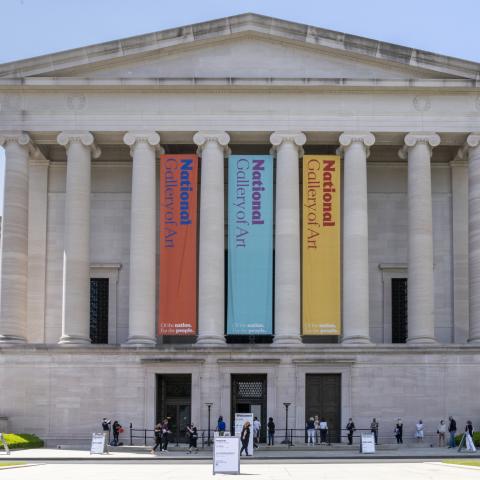Anthonij de Bordes and His Valet
c. 1648
Artist, Flemish, 1618 - 1664

Michael Sweerts combined unrelenting naturalism and timeless classicism, whether depicting beggars, exotic visitors from the Orient or elegant upper-class patrons. Born in Brussels, Sweerts travelled to Rome between the mid-1640s and mid-1650s, achieving great success. While there, Sweerts executed paintings for several Dutch merchants, including Anthonij de Bordes (1615–1678), a cloth merchant from Amsterdam who worked in Italy in the late 1640s. Sweerts portrayed De Bordes having his boot removed by a manservant, an unusual pictorial motif which subtly points to the sitter's social status. De Bordes is depicted as though he has just returned from a ride as dusk settles in, holding onto the bright red felt lining while his manservant tugs at a dust-covered boot. Discarded spurs and slippers lie next to the saddle, while his sword rests on the tapestry-draped table. His dog, possibly a Dutch kooiker hound, lies down behind his master to recover from the outing's exertion. The timbered plaster walls and dirt floor suggest that this scene takes place in the stable's tack room. Through the arched gate, the idyllic landscape includes a specific reference to Rome. The dove atop the obelisk is the symbol of the Pamphilj, one of the most powerful families in Rome at the time. In 1651 Camillo Pamphilj, nephew of the reigning Pope Innocent X (Giovanni Pamphilj), became Sweerts's most important patron. The obelisk in the painting's background thus subtly reinforces the message that both De Bordes and Sweerts moved among Rome's elite.
For both men the stay in Italy was temporary. By 1653, Anthonij de Bordes had returned to Amsterdam, where—in partnership with his older brother Boudewijn—he continued to be successful as a merchant in fine linen. Michael Sweerts had returned to Brussels, where he started a drawing academy, by 1656. He moved to Amsterdam around 1660, but soon afterwards joined a Catholic missionary group bound for India, where he died in 1664.

West Building Main Floor, Gallery 50-C
Artwork overview
-
Medium
oil on canvas
-
Credit Line
-
Dimensions
overall: 50.7 × 66.6 cm (19 15/16 × 26 1/4 in.)
framed: 69.85 × 86.36 × 5.72 cm (27 1/2 × 34 × 2 1/4 in.) -
Accession
2012.13.1
Artwork history & notes
Provenance
Probably the sitter; probably by inheritance to his daughter, Maria de Bordes [1655-1686]; probably by inheritance to her husband, Daniël Deutz [1644-1707];[1] by descent in the De Bordes family; by inheritance to C.J. de Bordes, Velp and Bussum, by 1907;[2] C.A. Van Walré de Bordes, The Hague; sold November 1984 through (S. Nystad, The Hague) to Dr. Arthur and Arlene Elkind, New Rochelle;[3] purchased 9 February 2012 by NGA.
[1] The painting corresponds to an entry in the estate inventory of Daniël Deutz compiled on 5 November 1708, in which is described, with no artist given, "een stuck daar den ouden Heer Anthonij de Bordes de laarsen werdt uijtgetrocken" [a piece showing Anthonij de Bordes the Elder having his boots removed]. Deutz married Maria de Bordes in 1677. See Guido M.C. Jansen, "A Family Tradition Confirmed: Sweerts's Portrait of Anthonij de Bordes," _The Hoogsteder Mercury_12 (1991): 37-41. Jansen speculates that Maria and Daniël's son, Anthony Deutz, may have owned the painting and that it must have been withheld from Anthony's 1731 auction "owing to its value as a family heirloom."
[2] W. Martin, ""Michiel Sweerts als schilder. Proeve van een Biografie en een Catalogus van zijn schilderijen," Oud Holland 25 (1907): 146-147, no. 5, repro.
[3] Nystad Oude Kunst Records, 1958-1994, accession number 970019, Research Library, Getty Research Institute, Los Angeles: box 13, folder: corresp. 1974-79, W; box 18, folder: corresp. 1980, W; box 25, folder: corresp. Amerika, 1985, D-F; box 41, folder: invoices, 1984; copies in NGA curatorial files.
Associated Names
Exhibition History
1982
A Collector's Choice: One hundred 17th century Dutch paintings principally from private collections, Mauritshuis, The Hague, 1982, no. 84, repro.
1988
Dutch and Flemish Paintings from New York Private Collections, National Academy of Design, New York, 1988, no. 50, repro.
2002
Michael Sweerts (1618-1664), Rijksmuseum, Amsterdam; Fine Arts Museums of San Francisco; Wadsworth Atheneum, Hartford, 2002, no. IV, repro.
2019
Rembrandt y el retratro en Amsterdam, 1590-1670 [Rembrandt and Amsterdam portraiture, 1590-1670], Museo Thyssen-Bornemisza, Madrid, 2020, no. 79, repro.
Bibliography
1907
Martin, Wilhelm. "Michiel Sweerts als schilder. Proeve van een Biografie en een Catalogus van zijn schilderijen." Oud Holland 25 (1907): 146-147, no. 5, repro.
1954
Kultzen, Rolf. "Michael Sweerts." 2 vols. Ph.D. dissertation, University of Hamburg, 1954: 254, no. 18.
1983
Waddingham, Malcolm. "Recently Discovered Paintings by Sweerts." Apollo 118, no. 260 (October 1983): 282, fig. 2.
1991
Jansen, Guido M.C. "A Family Tradition Confirmed: Sweerts's Portrait of Anthonij de Bordes." _The Hoogsteder Mercury_12 (1991): 37-41.
1996
Kultzen, Rolf. Michael Sweerts, Brussels 1618 - Goa 1664. Translated and edited by Diane L. Webb. Doornspijk, 1996: 16 n. 10, 24, 56, 56 n. 5, 96-97, no. 32, repro., as Master and Servant.
1998
Bikker, Jonathan. "The Deutz brothers, Italian paintings and Michiel Sweerts: new information from Elisabeth Coymans's Journael." Simiolus 26, no. 4 (1998): 301-302, fig. 21.
2020
Wheelock, Arthur K. Jr. “Pleasure and Prestige: The Complex History of Collecting Flemish Art in America.” In America and the Art of Flanders: Collecting Paintings by Rubens, Van Dyck, and Their Circles, edited by Esmée Quodbach. The Frick Collection Studies in the History of Art Collecting in America 5. University Park, 2020: 18, color fig. 11, 274 nt. 65.
Inscriptions
on saddle in right foreground, in monogram: MS
Wikidata ID
Q20177236


